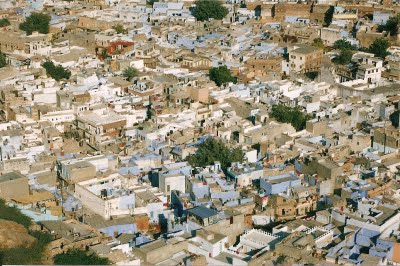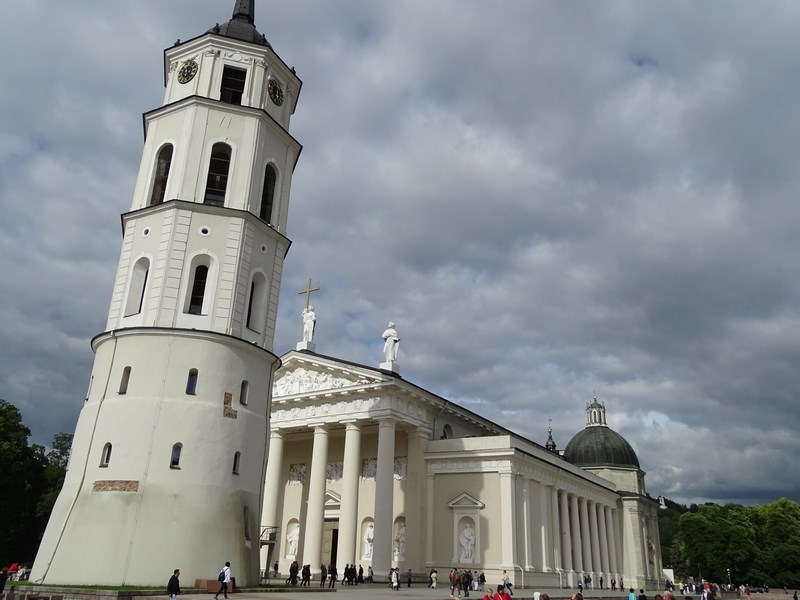Jodhpur – the Blue City of the Maharajahs
“Where from? Where from?” It is the 4217th “Where from?” I have heard since I got to India. It is the standard question which a vendor or a would-be guide uses to try to start a conversation with His Royal Highness, the Foreign Tourist, who would be me. “I am from Bhutan”, I answer bluntly. “It’s impossible” retorts the seller, amazed. “Yes, I am the adopted son of Bhutan’s King, the best friend of the Crown Prince and the fifth in line to inherit the crown.” The seller is left bewildered. Although I will often hear the word Bhutan around me, no seller will ask me where I come from again… Welcome to India ! Welcome to Jodhpur !
To a traveler,India is an experience. You cannot say that you like India or you do not, India is a unique experience that has to be lived, felt, and seen. India defines the ostentatious luxury, but also the fierce misery, which coexist at few steps away from each other. In any shop in India, you will be treated as a maharajah, but you must arm yourself with patience and sharp negotiating skills. In India, I saw the most incredible palaces, unrivaled hotels, restaurants you have to see to believe that such places exist, but also the most severe poverty and promiscuity. Obviously, if endowed with some adventurous spirit, you can shun the sordid parts and wonder at the “Incredible India”.
One of the richest areas is Rajasthan, located in the North, not far away from the capital,Delhi. The main touristic destinations are four cities, former “princely states”, mini-states ruled directly by Indian maharajahs and not by the British Crown, each city having a dominant colour – Jaipur “Pink City”, Jodhpur “Blue City”, Jaisalmer “Golden City” and Udaipur “White City”. Each place has its own story, so every city deserves special attention. Jodhpur is the “Blue City” – blue is the colour of the Brahmans, the upper caste in Indian society, and most families in the city center are Brahmans, so most houses are painted blue.
What attracts you in Jodhpur? – Firstly, the spectacular citadel Meherangarh – an imposing building, perhaps the most impressive city inIndia, perched on a mountain spur right in the middle of the city. Here was the Jodhpur Maharajahs residency… Although still owned by the Maharajah of Jodhpur, the palace can be visited, but be careful – the visit lasts for several hours, but you have a treat to a real festival of mogulo-Hindu architecture. Tired after all this gold and marble? With little luck, you can meet the official Fortune Teller of the Maharajah who has an office in the palace and, for 300 rupees (about 5 euro), he can guess your past and future. He guessed for me, too and I cannot say that he guessed wrongly, on the contrary, he got it quite right… But do not leave without seeing the plate with the traces of the hands of the fifteen wives of Maharajah Man Singh. Although Man was a modern leader, no longer keeping his wives in the purdah (the custom of the harem was taken from Muslims moguls), allowing them to ride or have fun, when he died, the wives had to observe the ancient sati custom – to throw themselves on the pyre on which the body of the deceased was burning and burn themselves alive alongside with their illustrious husband.
Tired of palaces, riddles, rikshas, shops, visitors? You cannot miss an imperial afternoon at the Umaid BhawanPalace! It is one of the most impressive palaces in India, built in 1930 when, during an economic crisis, the Maharajah decided to build this colossus in order to give jobs to unemployed (at the same time, in Germany and the U.S. , the same crisis was solved by building highways!). Today, Umaid Bhawan Palace is partly a luxury hotel, partly an art museum and partly the current maharajah’s dwelling place. In fact, walking you through the imposing interiors, you can actually come across His Majesty.
If interiors redefine luxury for any European traveler, the garden is an oasis of delight. In the evening, you can enjoy a sunset over the blue town blue, and waiters dressed in princely attires serve delicious food from the cuisine of the Great Moguls… And, so that the princely atmosphere should be complete, look around the huge garden – you will see dozens of peacocks, the princely birds of the Indian Maharajahs… You may be lucky and one of them may expose its spectacular tail.
When to travel to Jodhpur
Preferably in winter: November to April. In Jodhpur, in the middle of winter, temperatures can drop towards 10 degrees, but, right after April, temperatures explode beyond 40 degrees. The dry season is also in wintertime, most days being sunny, sometimes foggy. Avoid summer as much as you can – diluvium rains brought by the monsoon can cut communications, turning a pleasure trip into a nightmare.
How to get there
Jodhpur has a small airport and you can only find a few flights. Most of travelers arrive here by train from Jaipur, or sometimes by bus.
Indian Visa
Visa is required by everyone and it should be obtained in advance from the Indian Embassies abroad. I’ve seen some reports about difficulty of getting the Indian visa outside your own country (especially in Colombo), so if you can get it home, just do it !
Where to sleep in Jodhpur
Umaid Bhawan Palace , for a truly royal experience – starting price of 29,000 rupees (475 Euros). If not, there are various Havelis in the city, rich merchants’ houses converted into hotels with local flavour, such as Pal Haveli.
Where to eat:
If you do not sleep in style at the Umaid Bhawan Palace, it is compulsory to eat in the palace garden with peacocks. Other than that, reasonable restaurants of the central Havelis are a pleasant alternative. Many have roof top restaurants and you can even have a spectacular view towards the fort palace.
How to move around in Jodhpur
Hey, you’re in India, take a rickshaw! There are no “classic” rickshaws, drawn by men, most of them are motor-rickshaws, obviously somehow less comfortable than a car, but a rickshaw is a fundamental element of India and, in addition, you can visit several narrow streets of the Old City through which cars move like an elephant in a china shop window.
Jodhpur photos
The signs of the maharajah’s wives who committed sati
The Royal Palace of Meherangarh
Jodhpur – the Blue City !
Umad Bhawan Palace
Young dancer













